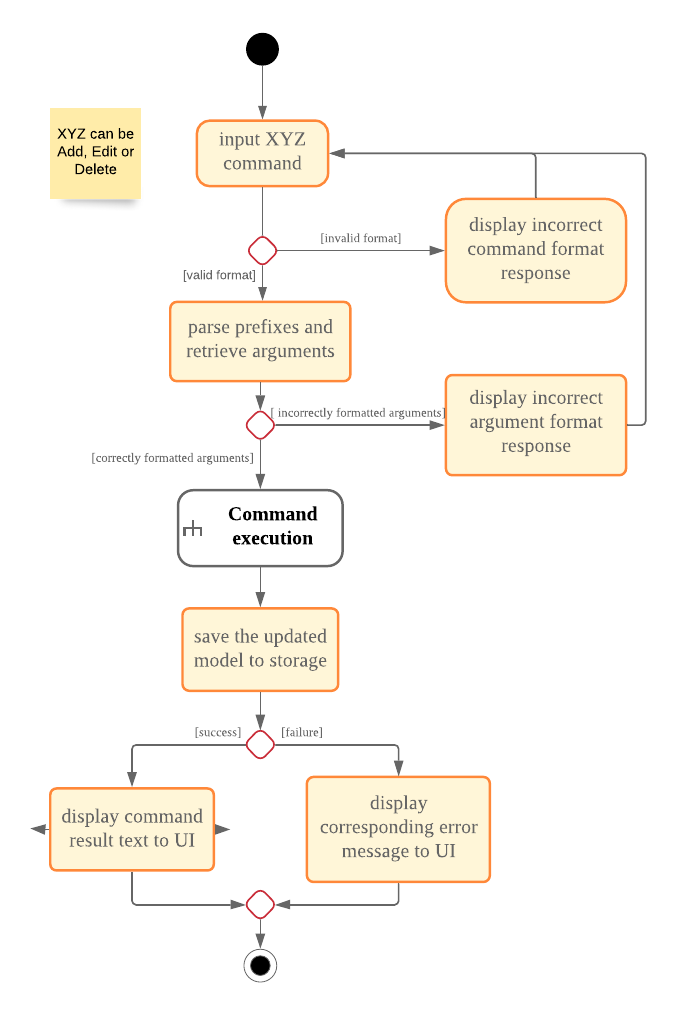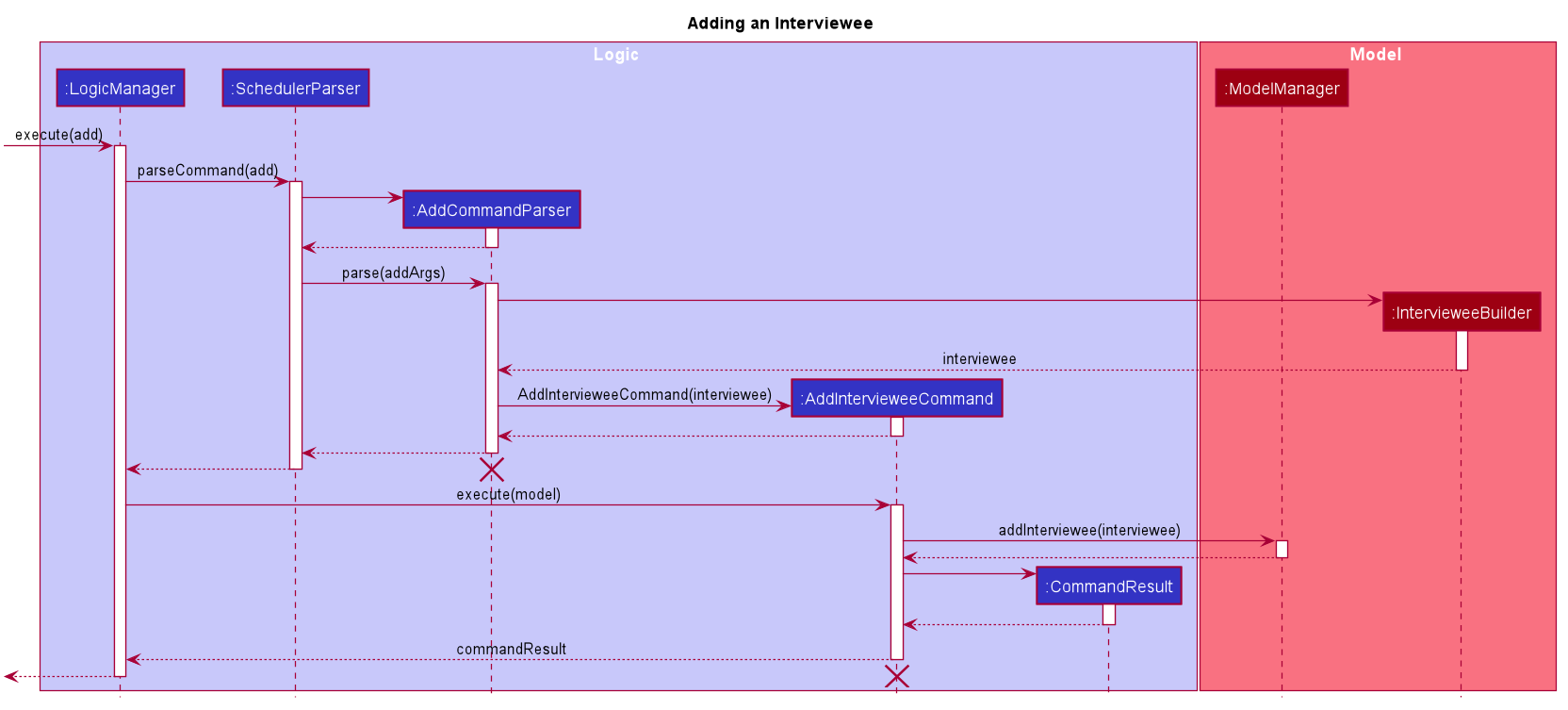Overview
People who hold leadership positions, especially those in student-led clubs, have to usually schedule interviews with those interested in applying to leadership positions during recruitment period. Usually, there are clashing preferred time slots between interviewees, which the interviewer has to slowly and manually resolve. We therefore came up with Scheduler, a desktop application used to automate and streamline the process of interview scheduling. Scheduler matches interviewees with interview time slots to generate an optimal interview timetable. The user interacts with it using a CLI, and it has a GUI created with JavaFX. It is written in Java, and has about 20 kLoC.

Summary of contributions
-
Major enhancement: added the ability to manually
add,editanddeleteentities (interviewees and interviewers) in Scheduler.-
What it does: This allows the user to manually alter the data currently in Scheduler .
-
Justification: This feature is necessary to the product as interview schedules change frequently - interviewees may suddenly be unable to attend an interview and withdraw from the interview. Interviewers may also be forced to withdraw due to urgent business. There may also be more applicants, and hence interviewees. In these cases, the ability to manually change data in Scheduler is essential.
-
Highlights:
-
This enhancement deeply affects the foundational structure of Scheduler in
LogicandModel. -
It requires an in-depth understanding of the existing code base, concepts like regex expression design to ensure input validity and the Jackson library to convert objects to JSON format.
-
The implementation was also challenging as it required changes to existing commands and deletion of irrelevant fields that were highly coupled to other components. The large number of possible input arguments for these commands (e.g the
addcommand has 8 possible input prefixes) also each required extensive testing to ensure users could not input invalid values.
-
-
Credits: Joshua Bloch, author of Effective Java, for his ideas on Builder patterns as a way to generate objects with optional parameters.
-
-
Minor enhancement: Added the
clearcommand, allowing the user to clear all entities and schedules from Scheduler’s internal model. -
Code contributed: [View on RepoSense]
-
Other contributions:
-
Project management:
-
Contributed non-trivially to pull request code discussion: (pull requests #90, #158)
-
Coordinated assignment of bugs after mock practical exam: (github issues page)
-
-
Enhancements to existing features:
-
Documentation:
-
Did cosmetic and structural tweaks to existing contents of the User Guide to improve readability: (pull request #156)
-
-
Community:
-
Contributed to forum discussion: (example 1)
-
-
Contributions to the User Guide
Given below are sections I contributed to the User Guide. They showcase my ability to write documentation targeting end-users. |
Add interviewees/interviewers manually add
Manually add a new entity to the database. The command format differs on the preamble supplied, which should be interviewee or interviewer:
-
If
intervieweeis supplied, refer to Adding a new interviewee below. -
If
intervieweris supplied, refer to Adding a new interviewer below.
Adding a new interviewee
Manually add a new interviewee to the database.
Format: add interviewee n/NAME p/PHONE f/FACULTY y/YEAR_OF_STUDY ep/PERSONAL_EMAIL ew/NUS_WORK_EMAIL d/DEPARTMENT… s/SLOT… [t/TAG]…
Example:
add interviewee n/John Doe p/91234567 f/School of Computing y/1 ep/john_doe@gmail.com ew/john_doe@u.nus.edu d/Marketing s/17/10/2019 13:30-14:00 t/friends
Notes:
-
If a name prefix
n/is supplied, theNAMEgiven should not match (case-insensitive) that of other interviewees already in Scheduler.-
John DoitandJohn Do itare considered different names.
-
Adding a new interviewer
Manually add a new interviewer to the database.
Format: add interviewer n/NAME p/PHONE ew/NUS_WORK_EMAIL d/DEPARTMENT s/SLOT… [t/TAG]…
Example:
add interviewer n/Mary Jane p/98765432 ew/mary_jane@u.nus.edu d/Marketing s/20/09/2019 18:00-18:30
Notes:
-
If a name prefix
n/is supplied, theNAMEgiven should not match (case-insensitive) that of other interviewers already in Scheduler.-
John DoitandJohn Do itare considered different names.
-
Constraints:
-
A
n/NAMEmust only contain alphanumeric characters and spaces, and should not be blank. -
A
p/PHONEmust only contain numbers, and should be at least 3 digits long. -
A
f/FACULTYcan take any value in English, but should not be blank. -
A
y/YEAR_OF_STUDYmust be a positive integer within the range [1,5]. -
A
ep/PERSONAL_EMAILorew/NUS_WORK_EMAILmust be of format local-part@domain.-
The local-part must only contain alphanumeric characters and special characters ( !#$%&'*+/=?`{|}~^.- ), excluding the parenthesis.
-
The domain name must at least be 2 characters long, start and end with alphanumeric characters and consist of alphanumeric characters, with a period or a hyphen for the characters in-between, if any.
-
-
A
d/DEPARTMENTshould be in English, and should not be blank. -
A
t/TAGmust only be alphanumeric and one word, i.et/catLoveris correct whilet/cat loveris not. -
s/SLOTmust follow the format:dd/MM/yyyy HH:mm-HH:mm, where dd/MM/yyyy refers to a date, the leftmost HH:mm refers to the start duration and the rightmost HH:mm refers to the end duration. -
The date dd/MM/yyyy must strictly be a valid date, i.e 30/02/2019 cannot be supplied as a date.
-
The start duration and end duration of a
s/SLOTmust follow these constraints:-
A start duration and end duration must be in 24-hour format.
-
The range of start durations and end durations available for input must be within Working Hours.
-
The start duration must be earlier than the end duration, and be in increments of
duration. The time elapsed from the start duration to end duration must also follow the number of minutes as specified by the value ofdurationin User Preferences. Otherwise, scheduled data will not be displayed properly in the user interface. See Duration of Timeslot for more details.
-
Edit interviewees/interviewers manually edit
Manually edit an entity in the database. The command format depends on the r/ROLE prefix supplied:
-
If
intervieweeis supplied, refer to Edit an existing interviewee below. -
If
intervieweris supplied, refer to Edit an existing interviewer below.
Edit an existing interviewee
Manually edit an existing interviewee in the database.
Format: edit NAME r/interviewee [n/NAME] [p/PHONE] [f/FACULTY] [y/YEAR_OF_STUDY] [ep/PERSONAL_EMAIL] [ew/NUS_WORK_EMAIL]
[d/DEPARTMENT]… [s/SLOT]… [t/TAG]…
Notes:
-
An empty tag prefix
t/can be supplied to reset the tags of an interviewee. -
If a department prefix
d/is supplied, at least one valid, non-empty department must be provided. -
If a slot prefix
s/is supplied, at least one valid, non-empty slot must be provided. -
If a name prefix
n/is supplied, theNAMEgiven should not match (case-insensitive) that of other interviewees.-
John DoitandJohn Do itare considered different names.
-
Example:
edit John Doe r/interviewee p/91234567 f/School of Computing s/05/11/2019 18:30-19:00
Edit an existing interviewer
Manually edit an existing interviewer in the database.
Format: edit NAME r/interviewer [n/NAME] [p/PHONE] [t/TAG]… [d/DEPARTMENT] [ew/NUS_WORK_EMAIL] [s/SLOT]…
Notes:
-
An empty tag prefix
t/can be supplied to reset the tags of an interviewer. -
If a slot prefix
s/is supplied, at least one valid, non-empty slot must be provided. -
If a name prefix
n/is supplied, theNAMEgiven should not match (case-insensitive) that of other interviewers.-
John DoitandJohn Do itare considered different names.
-
Example:
edit John Doe r/interviewer p/91234567 s/05/11/2019 18:30-19:00
Contributions to the Developer Guide
Given below are sections I contributed to the Developer Guide. They showcase my ability to write technical documentation and the technical depth of my contributions to the project. |
Logic component
This section shows how the Logic component is structured. The class diagram below shows an overview of the Logic component:

-
XYZinXYZCommandcan either be: Add, Edit, Delete, Clear, Exit, Help, Import, Export, Email, Schedule or Display. -
XYZinXYZCommandParsercan either be Add, Edit, Delete, Import, Export, Email, Schedule or Display. -
The dependencies of
XYZCommandwith thegraphpackage shown in the Class Diagram only applies toScheduleCommand.
API :
Logic.java
The Logic component mainly handles the parsing of user input and creation of commands to execute, which in turn affects
the Model and Storage components.
A command entered by the user is processed as follows:
-
Logicuses theSchedulerParserclass to parse the user command, producing aCommandobject. -
This
Commandobject is executed byLogicManager, which may affectModel(e.g adding an interviewee). -
The execution produces a result, which is encapsulated in a
CommandResultobject and returned toLogicManager. -
LogicManagerthe processes theCommandResult. TheCommandResultcan instruct toUito perform certain actions, such as displaying help to the user. -
Finally,
LogicManagercalls theStoragecomponent to save the currentModelto the hard disk.
Given below is the general Sequence Diagram for interactions within the Logic component for the execution of the add,
edit and delete API calls. Refer to Section 3: Implementation for how different Command objects
are executed and how they influence other components.

add, edit and delete Commands
The lifeline for XYZCommandParser and XYZCommand should end at the destroy marker (X) but due to a limitation of PlantUML, the lifeline reaches the end of diagram.
|
Add, Edit and Delete feature
The add, edit and delete features allow interviewees and interviewers to be manually added to Scheduler.
The flow of logic for a successful execution of these commands can be summarised as follows:
-
Parse user input and populate an
ArgumentMultimapinstance with a mapping of prefixes (from user input) to String arguments following those prefixes. -
Check the validity of these arguments using the
ParserUtilclass. -
If the arguments are valid, carry out the necessary modifications to the
ModelManagerclass, which contains the underlyingIntervieweeListandInterviewerList, which we store our entities in.
The Activity Diagram below further illustrates the general flow of logic from command input (by a user) to command execution:

Logic component.| The box labelled "Command execution" is a rake. It indicates that part of the activity is given as a separate diagram. Each of add, edit and delete provide their own versions of "Command execution". |
Add Interviewee/Interviewer feature
The add command feature allows a user to add an Interviewee or Interviewer object to the underlying IntervieweeList
or InterviewerList of ModelManager.
-
Upon successful parsing of the
addcommand arguments, an instance ofInterviewee/Intervieweris created. (depending on the preamble supplied in the user input)-
I.e:
add interviewee n/John Doe. The preamble starts after the command word "add" and before the first prefix "n/".
-
-
ModelManager#addInterviewee() is then called to add the entity to its corresponding list in
ModelManager.-
The underlying
UniquePersonListofIntervieweeListandInterviewerListensures that no duplicate entities are present at any time, checked by Interviewee#isSamePerson() and Interviewer#isSamePerson().
-
The following Sequence Diagram illustrates how the add interviewee command works. The add interviewer command works in a similar manner.

The lifeline for AddCommandParser and AddIntervieweeCommand should end at the destroy marker (X) but due to a limitation of PlantUML, the lifeline reaches the end of diagram.
|
-
See the general logic diagram in Section 2.3: Logic component for a more complete view of how
Storageis affected as well. -
For brevity, the input arguments to functions referenced in this guide may be omitted.
To better illustrate the flow of events from the moment a user inputs an add command till completion of the command, the continuation of the rake from the general activity diagram is shown below:
